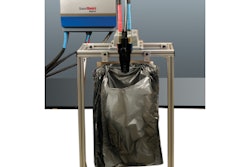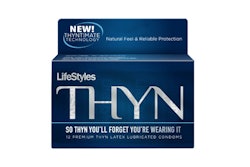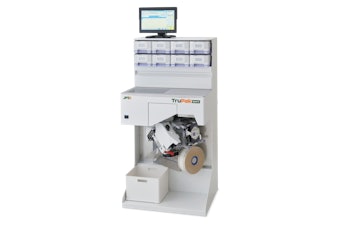ViSi Mobile™ by Sotera Wireless Inc., was unveiled as a system that “could be the future of medical monitoring,” during the Medical Design & Manufacturing East (MD&M East) trade show. The system leverages the design flexibility, chemical resistance, and durability of Eastman Tritan™ copolyester from Eastman.
Eastman worked with three key partners on the project: Design consultancy DD Studio, polymer material provider PolyOne Corp., and custom injection-molder Phillips Plastics Corp..
The ViSi Mobile system includes a wireless device that straps to a patient's arm to monitor vital signs, such as blood pressure and heart rate; a monitoring device to keep clinicians connected to patients' information; and a charging station.
“When Sotera Wireless approached us with this medical-device design concept, it wanted the look and feel of a small, user-friendly consumer product, but had a number of specific demands. The device had to be chemical-resistant, durable, easy-to-clean, and submersible under water. We weren't sure the design was possible,” said Michael Swartz, growth strategist, DD Studio. “But, by working with Eastman's technical experts, we were able to specify Eastman Tritan copolyester as a material solution to make the innovative design a reality and meet the device's performance requirements.”
The device's lens, housing, printed circuit board assembly and connectors are made with Eastman Tritan copolyester MX711. The cold-swaging ability of Tritan allows for fit and press assembly of the device, which offers a tight, smooth, continuous fit between parts; allows for joining parts without the use of chemicals, adhesives or mechanical fasteners; and saves energy. By utilizing Tritan, the device features superior resistance to chemicals used in disinfectants and cleansers--without cracking or crazing. The material also exceeded durability requirements, which is valuable in mobile devices that are used frequently or could be dropped or damaged should a patient fall.
To protect the device from water and fluids found in the hospital environment, it had to meet IPX7 requirements of withstanding water submersion for 60 minutes at a depth of 1 meter. DD Studio relied on compatibility samples and testing results from PolyOne to select GLS Versaflex™ OM 3060 TPE. It adheres to the Eastman Tritan copolyester substrate to seal the device housing, including speaker port and microphone, from water seepage and protect internal electronics.
DD Studio and the product development team worked with Phillips Plastics to ensure the manufacturability of the design. Phillips Plastics took the designs DD Studio created and conducted a detailed DFM exercise and created market-entry prototype tooling.
“Contemporary plastic materials, such as Eastman Tritan copolyester, are well-positioned to respond to the trend in the healthcare industry toward durable, reliable wireless devices that enhance patient safety and comfort,” said Scott Hanson, global industry leader, medical market segment, Specialty Plastics Business, Eastman. “Development of the Sotera Wireless device is an example of how early and ongoing interaction between material suppliers and designers is truly effective to bring next-generation devices to the marketplace.”
-Edited by Jim Butschli
Eastman worked with three key partners on the project: Design consultancy DD Studio, polymer material provider PolyOne Corp., and custom injection-molder Phillips Plastics Corp..
The ViSi Mobile system includes a wireless device that straps to a patient's arm to monitor vital signs, such as blood pressure and heart rate; a monitoring device to keep clinicians connected to patients' information; and a charging station.
“When Sotera Wireless approached us with this medical-device design concept, it wanted the look and feel of a small, user-friendly consumer product, but had a number of specific demands. The device had to be chemical-resistant, durable, easy-to-clean, and submersible under water. We weren't sure the design was possible,” said Michael Swartz, growth strategist, DD Studio. “But, by working with Eastman's technical experts, we were able to specify Eastman Tritan copolyester as a material solution to make the innovative design a reality and meet the device's performance requirements.”
The device's lens, housing, printed circuit board assembly and connectors are made with Eastman Tritan copolyester MX711. The cold-swaging ability of Tritan allows for fit and press assembly of the device, which offers a tight, smooth, continuous fit between parts; allows for joining parts without the use of chemicals, adhesives or mechanical fasteners; and saves energy. By utilizing Tritan, the device features superior resistance to chemicals used in disinfectants and cleansers--without cracking or crazing. The material also exceeded durability requirements, which is valuable in mobile devices that are used frequently or could be dropped or damaged should a patient fall.
To protect the device from water and fluids found in the hospital environment, it had to meet IPX7 requirements of withstanding water submersion for 60 minutes at a depth of 1 meter. DD Studio relied on compatibility samples and testing results from PolyOne to select GLS Versaflex™ OM 3060 TPE. It adheres to the Eastman Tritan copolyester substrate to seal the device housing, including speaker port and microphone, from water seepage and protect internal electronics.
DD Studio and the product development team worked with Phillips Plastics to ensure the manufacturability of the design. Phillips Plastics took the designs DD Studio created and conducted a detailed DFM exercise and created market-entry prototype tooling.
“Contemporary plastic materials, such as Eastman Tritan copolyester, are well-positioned to respond to the trend in the healthcare industry toward durable, reliable wireless devices that enhance patient safety and comfort,” said Scott Hanson, global industry leader, medical market segment, Specialty Plastics Business, Eastman. “Development of the Sotera Wireless device is an example of how early and ongoing interaction between material suppliers and designers is truly effective to bring next-generation devices to the marketplace.”
-Edited by Jim Butschli
Companies in this press-release






















